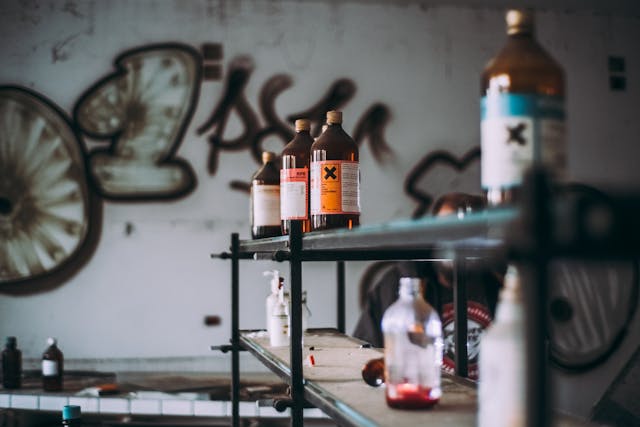
How does anthrax kill? Anthrax is an infection caused by a bacterium called Bacillus anthracis. Because it is a bacterial infection, it can be treated with antibiotics if it is discovered soon enough.
We may have heard about anthrax from the news, but it is a naturally occurring bacteria that has been around for a long time. It is possible that it has been infecting humans for a long time, but many experts think the first cases of human anthrax were in Egypt and Mesopotamia thousands of years ago. There is a theory that the fifth plague that Moses called down upon the Egyptians was actually anthrax. It was a plague that affected horses, cattle, sheep, camels, and oxen, which is something that anthrax would do. Various historians write about plagues over the eras, many of which could have been anthrax. The plague that almost brought down the Roman Empire in the 2nd century AD was most likely anthrax as well.
Why is anthrax so deadly? The bacteria produces a toxin that is made up of three different proteins. One of the proteins is called protective antigen and helps the anthrax bacteria get into cells where it can produce the other two proteins and replicate itself. The second protein is called edema factor, and it makes the body produce adrenaline. The cells become hyperactive, and they burn through all of their stored energy. The cells finally die, and they release their water, causing swelling in the surrounding tissue. The third protein is called lethal factor, and it can kill the immune cells that the body sends to fight the bacteria. That means it is very difficult for the body to shift the anthrax bacteria on its own and without antibiotics, it is a very dangerous bacterium. The three proteins are not dangerous on their own and it is only because the anthrax bacterium has evolved to use all three proteins together that it is so dangerous.
We usually come into contact with anthrax by coming into contact with animals that are infected with it. The anthrax bacterium lives in soil and is not that hardy, but it can exist as spores that are very resilient and can lay dormant for extremely long periods of time before they are eaten or inhaled by an animal. Once the animals have ingested the bacteria and it has gone to work, we can be infected. The first way is through the skin. This is the least dangerous method because our skin is easily strong enough to stop the bacteria or the spores getting through. The problem comes if there is a slight cut or scratch on the skin and the bacteria can get inside. Once they are inside, they go to work. This is the most common way of catching anthrax and 95% of cases come from coming into contact with infected animals. The mortality rate is only about 20%.
The second way is slightly more dangerous, but much less common. It is called gastrointestinal anthrax, and it comes from eating infected meat. The anthrax bacterium can be killed by temperatures of 60℃ for 30 minutes or 100℃ for 5 minutes, so you are not likely to get anthrax this way unless you are eating raw or not properly cooked meat. The bacteria go through the wall of the intestines and into the bloodstream, where they can spread around the body. The mortality rate ranges from 25% to 75% depending on many factors.
The third method is the least common, yet the most deadly. Inhalation anthrax kills almost 90% of people that are infected in this way. It is caused when people breathe in anthrax spores. The anthrax bacterium cannot survive for long in the open, but the spores can, and they are very small and light. If someone breathes in spores, it is not the end of the world, because we do have good defense systems. The spores can get caught in nasal hairs, or trapped by mucus, or caught in the throat, or any number of things. However, if you breathe in enough of the spores, estimates say about 50,000, some of them may manage to get down to the lungs where they can pass through to the lymph nodes in the chest. They go to work producing their toxins and body fluid starts to build up in the chest, making it difficult to breathe. The bacteria can then spread through the lymphatic system, taking the toxins all over the body, usually resulting in death. Inhalation anthrax isn’t always fatal, but the time from the onset of symptoms to death is often too quick to do anything about it. And this is the reason why terrorists want anthrax spores and why they are sent through the post to people. A study in 1970 estimated that 100 kg of anthrax spores released from a plane over Washington D.C. would kill between 130,000 and 3 million people. And this is what I learned today.
Photo by Davide Baraldi: https://www.pexels.com/photo/glass-bottles-on-shelf-1771809/
Sources
https://pubmed.ncbi.nlm.nih.gov/26386727
https://cordis.europa.eu/article/id/151258-evolution-of-the-anthrax-bacterium
https://pubmed.ncbi.nlm.nih.gov/15081505
https://www.cdc.gov/anthrax/basics/anthrax-history.html
https://www.cdc.gov/anthrax/basics/index.html
https://www.cbsnews.com/news/inhalation-anthrax-why-is-it-so-deadly
https://www.ph.ucla.edu/epi/bioter/sciwhyanthraxdeadly.html
https://en.wikipedia.org/wiki/Anthrax_toxin
https://www.vinmec.com/en/news/health-news/general-health-check/why-is-anthrax-dangerous
